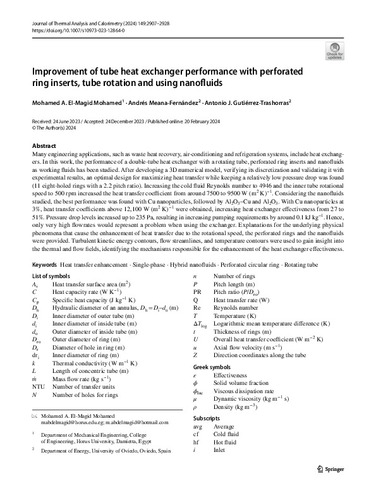Improvement of tube heat exchanger performance with perforated ring inserts, tube rotation and using nanofluids
Autor(es) y otros:
Fecha de publicación:
Versión del editor:
Citación:
Resumen:
Many engineering applications, such as waste heat recovery, air-conditioning and refrigeration systems, include heat exchangers. In this work, the performance of a double-tube heat exchanger with a rotating tube, perforated ring inserts and nanofuids as working fuids has been studied. After developing a 3D numerical model, verifying its discretization and validating it with experimental results, an optimal design for maximizing heat transfer while keeping a relatively low pressure drop was found (11 eight-holed rings with a 2.2 pitch ratio). Increasing the cold fuid Reynolds number to 4946 and the inner tube rotational speed to 500 rpm increased the heat transfer coefcient from around 7500 to 9500 W (m2 K)−1. Considering the nanofuids studied, the best performance was found with Cu nanoparticles, followed by Al2O3–Cu and Al2O3. With Cu nanoparticles at 3%, heat transfer coefcients above 12,100 W (m2 K)−1 were obtained, increasing heat exchanger efectiveness from 27 to 51%. Pressure drop levels increased up to 235 Pa, resulting in increasing pumping requirements by around 0.1 kJ kg−1. Hence, only very high fowrates would represent a problem when using the exchanger. Explanations for the underlying physical phenomena that cause the enhancement of heat transfer due to the rotational speed, the perforated rings and the nanofuids were provided. Turbulent kinetic energy contours, fow streamlines, and temperature contours were used to gain insight into the thermal and fow felds, identifying the mechanisms responsible for the enhancement of the heat exchanger efectiveness.
Many engineering applications, such as waste heat recovery, air-conditioning and refrigeration systems, include heat exchangers. In this work, the performance of a double-tube heat exchanger with a rotating tube, perforated ring inserts and nanofuids as working fuids has been studied. After developing a 3D numerical model, verifying its discretization and validating it with experimental results, an optimal design for maximizing heat transfer while keeping a relatively low pressure drop was found (11 eight-holed rings with a 2.2 pitch ratio). Increasing the cold fuid Reynolds number to 4946 and the inner tube rotational speed to 500 rpm increased the heat transfer coefcient from around 7500 to 9500 W (m2 K)−1. Considering the nanofuids studied, the best performance was found with Cu nanoparticles, followed by Al2O3–Cu and Al2O3. With Cu nanoparticles at 3%, heat transfer coefcients above 12,100 W (m2 K)−1 were obtained, increasing heat exchanger efectiveness from 27 to 51%. Pressure drop levels increased up to 235 Pa, resulting in increasing pumping requirements by around 0.1 kJ kg−1. Hence, only very high fowrates would represent a problem when using the exchanger. Explanations for the underlying physical phenomena that cause the enhancement of heat transfer due to the rotational speed, the perforated rings and the nanofuids were provided. Turbulent kinetic energy contours, fow streamlines, and temperature contours were used to gain insight into the thermal and fow felds, identifying the mechanisms responsible for the enhancement of the heat exchanger efectiveness.
ISSN:
Ficheros en el ítem





